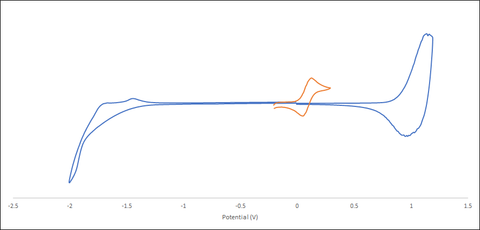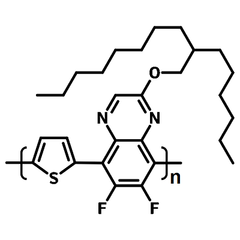PTQ10
CAS Number 2270233-86-6
Green Energy Materials, Luminosyn™ Polymers, OPV Polymers, Organic Conductors, Semiconducting Polymers
PTQ10, highly efficient polymer semiconductor
Low cost, high purity polymer available online for fast, secure dispatch
PTQ10 (CAS number 2270233-86-6) is a donor–acceptor (D–A) type copolymer with a simple thiophene ring as the electron donor unit and quinoxaline (QX) as electron acceptor unit. The alkoxy side chain attached on quinoxaline unit is to promote solubility and to enhance absorption of the targeted polymer. Difluoro substituted quinoxaline can further down-shift the HOMO energy level, achieve fast charge separation and low nonradiative recombination loss in the PSCs leading to high VOC and JSC.
Comparing with some other polymer semiconducting materials, PTQ10 has a simple structure which could lead to mass production with low cost. PTQ10 can also be processed in solution with eco-friendly non-halogenated solvents, i.e. o-xylene. The combined effects of high efficiency, low cost and green solvents processibility makes PTQ10 an ideal candidate for large scale doctor-blading and inkjet printing device fabrications.
Organic polymer solar cells based on PTQ10:Y6 blend shows efficient charge separation, higher photoluminescence quenching efficiency and higher charge mobilities, giving a power conversion efficiency of 16.53%.
Device structure: ITO (indium tin oxide)/PEDOT:PSS/PTQ10:Y6/PDINO/A1 [1]
Donar-acceptor (D-A) type copolymer
For high efficient OPV applications
Luminosyn™
High purity, batch-specific GPC data, available larger batch orders and higher molecular weight
Worldwide shipping
Quick and reliable shipping
Green energy materials
Processable in non-halogenated solvents
| Thickness (nm) | VOC (V) | JSC (mA cm-2) | FF (%) | PCE (%) |
| 110 nm | 0.826 | 26.65 | 75.1 | 16.53 |
Luminosyn™ PTQ10
Luminosyn™ PTQ10 is now available.
High purity
PTQ10 is purified by Soxhlet extraction with methanol, hexane and chlorobenzene under an argon atmosphere
Batch-specific GPC data
Batch specific GPC data is always available for your thesis or publication
Large-quantity orders
Plan your experiments with confidence with polymers from the same batch
General Information
| Full name | Poly [[6,7-difluoro[(2-hexyldecyl)oxy]-5,8-quinoxalinediyl]-2,5-thiophenediyl ]] |
| Synonyms | PTQ10 |
| Chemical formula | (C28H36F2N2OS)n |
| CAS number | 2270233-86-6 |
| UV-Vis absorption | λmax 556 nm, 600 nm in CB as-cast film |
| HOMO / LUMO | HOMO = -5.54 eV, LUMO = -2.98 eV [1] |
| Solubility | o-xylene, chloroform, chlorobenzene and dichlorobenzene |
| Processing solvent | o-xylene, chloroform, chlorobenzene |
| Classification / Family | Organic semiconducting materials, Wide band-gap polymers, Organic Photovoltaics, Polymer solar cells, NF-PSCs, All-polymer solar cells (all-pscs), Clean energy materials. |
Chemical Structure

Characterisations
UV-Vis Absorption

Cyclic Voltammetry

The cyclic voltammograms (CV) measurements were recorded on Ossila Potentiostat by using a three-electrode system with platinum disc as the working electrode, platinum wire as the counter electrode, Ag/Ag+ electrode as the reference electrode with a scanning rate of 100 mV/s in a 0.1 M tetrabutylammonium perchloroate Bu4NClO4) solution. The potential of Ag/Ag+ reference electrode was internally calibrated by using ferrocene/ferroncenium (Fc/Fc+) as the redox couple.
MSDS Documentation
Pricing
| Batch | Quantity | Price |
| M2283A1 | 100 mg | £380 |
| M2283A1 | 250 mg | £760 |
| M2283A1 | 500 mg | £1300 |
| M2283A1 | 1 g | £2500 |
| M2283A1 | 5 g / 10 g* | Please enquire |
*for 5 - 10 grams order quantity, the lead time is 4-6 weeks.
Batch details
| Batch | Mw | Mn | PDI | Stock Info |
| M2283A1 | 62,379 | 35,445 | 1.76 | In stock |
Literature and Reviews
- Rationally pairing photoactive materials for high-performance polymer solar cells with efficiency of 16.53%, Y. Wu et al., Sci China Chem., 63: 265–271 (2020); DOI: 10.1007/s11426-019-9599-1.
- Achieving Fast Charge Separation and Low Nonradiative Recombination Loss by Rational Fluorination for High-Efficiency Polymer Solar Cells, C. Sun et al., Adv. Mater., 31, 1905480 (2019); DOI: 10.1002/adma.201905480.
- Exciton and Charge Carrier Dynamics in Highly Crystalline PTQ10:IDIC Organic Solar Cells, H. Cha et al., Adv. Energy Mater., 10 (38) 2001149 (2020); DOI: 10.1002/aenm.202001149.

 PTQ10 MSDS sheet
PTQ10 MSDS sheet